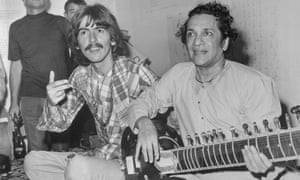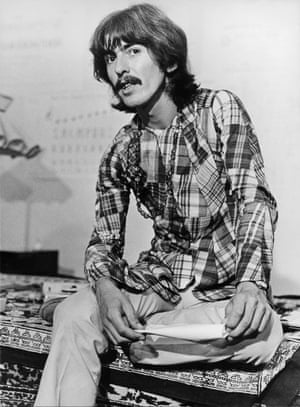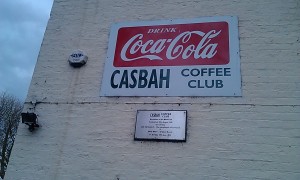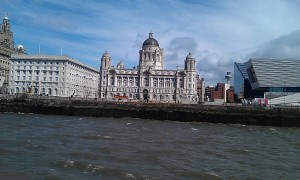Almost 50 years ago, the Beatle stepped aside from the planet’s biggest band to create the soundtrack to Joe Massot’s movie Wonderwall. With the help of India’s finest musicians, he invented the idea of the world music crossover

Let’s call it the Riddle of the Dark Horse: what do you get if you cross a Monkee, two Beatles, the man they called God, Paul McCartney’s banjo, India’s musical elite and a film about a mad professor spying on a Biba girl called Penny Lane?
The answer is Wonderwall Music. Released on 1 November 1968, three weeks before the White Album, George Harrison’s heartfelt, happily eccentric film soundtrack was the first solo record by a Beatle, the first album on the Apple label and a world music crossover before such a notion even existed. That it later lent its name to a Britpop anthem is easily the least interesting thing about it.
Newly rereleased in a boxset of Harrison’s solo work, Wonderwall Music encompasses tambura drones, Vedic chants, skiffle, ragtime, clip-clopping country, wah-wah squalls, woozy Mellotron, experimental sonic collage and, on Ski-ing, 100 seconds of Eric Clapton at his most raggedly explosive. The sound of Harrison’s musical curiosity taking flight, it is also an implicit expression of his disaffection within the Beatles, perhaps even an intimation of the beginning of the end.
After the Beatles ceased touring in August 1966, Harrison spent six weeks in India with Ravi Shankar, an immersion that led to a chain reaction of musical and spiritual epiphanies. On his return, his contribution to Sgt Pepper was the quietly assertive Within You Without You; much of the album left him cold. He was scarcely more enthusiastic about Magical Mystery Tour. While McCartney worked on the title track in the studio, Harrison produced coloured crayons from his painted sheepskin jacket and started drawing pictures. “My problem, basically, was that I was in another world,” he later said. “I didn’t really belong; I was just an appendage.”
Little wonder he jumped at an invitation, from American director Joe Massot, to compose music for Wonderwall, a film starring Jane Birkin as the objectified model who sends her oddball neighbour, Mr Collins (Jack MacGowran), into a voyeuristic frenzy. With its pop-art palette, psychedelic sex scenes, dingy domesticity and an uncredited Anita Pallenberg, Wonderwall is a curious period piece, less Blow-Up than Come Down. “It’s aged badly,” Birkin says. “I wasn’t very interesting! I was disappointed, but there are rather wonderful decors. And George was lovely.”
Massot, who died in 2002, sought original instrumental music for the film’s many dialogue-free scenes, and promised Harrison a free hand. “George took advantage of this by including a lot of Indian music in his score,” says John Barham, who worked on the project as arranger, player and a kind of conceptual interlocutor. Having studied at the feet – literally – of Shankar, Harrison’s understanding of Indian music had deepened beyond the naive sitar burr heard three years previously on the Beatles’ Norwegian Wood. He viewed Wonderwall Music as “partly an excuse for a musical anthology to help spread the word”, he said. “I used all these instruments that weren’t as familiar to western people as they are now, like shehnais, santoor, sarod, surbahars, tabla tarangs.”
Heavily spiced with Indian flavours it may be, but the album is a beguiling mixture of competing passions. Visiting Twickenham film studios, Harrison “spotted” each scene, marking where the music would be inserted, then working up basic themes at his home in Esher in Surrey. Initial recordings were made at Abbey Road on 22 and 23 November 1967, with harmonica maestro Tommy Reilly, session mainstay Jim Sullivan, and the Remo Four, a Liverpool quartet from Brian Epstein’s Nems stable. The Beatles’ manager had been dead only three months; Harrison may have felt the need to maintain a connection.

“We recorded backing tracks to accompany certain points in the film,” says Remo Four drummer Roy Dyke. “George had timed it all with a stopwatch: ‘We need one minute and 35 seconds with a country and western feel.’ Or, ‘We need a rock thing for exactly two minutes.’ Nothing was really written. We’d talk over ideas he wanted, play something, and he’d say, ‘That’s good, keep that. I like the piano there.’ It was very experimental. The idea was to set an atmosphere.”
Some of the results are lovely: the stately piano waltz of Red Lady Too; the richly cinematic Wonderwall to Be Here, on which Tony Ashton’s rippling piano melody is framed by Barham’s strings. The exotically funky On the Bed was inspired by a visit Harrison had made the previous year to BBC Television Centre, where Barham and Shankar were working on the music for Jonathan Miller’s production of Alice in Wonderland. “We were recording a scene where Ravi soloed and I played an accompanying Indian jhala [a rapid climactic flourish] texture on piano,” Barham says. “George was fascinated by the combination of sitar and piano. Back at Abbey Road, I played flugelhorn over George’s jhala. Later that day, Big Jim Sullivan, who was recording with Tom Jones, happened to drop in and played bass on the same track. It was a free atmosphere on those sessions. They were very creative and enjoyable.”
Wonderwall’s most experimental five minutes are Dream Scene, a sonically disorientating pick-and-mix of ambient backwards guitar, swooning Bollywood love calls, wailing flutes, treated electronics, disjointed harmonicas, atonal pianos, air-raid sirens, the chimes of a grandfather clock, nightmarish sampled voices and church bells. Harrison later dismissed it as “horrible stuff”, but it is not entirely fanciful to view Dream Scene as an enabling step towards the Beatles’ Revolution 9, the avant-garde sound collage pieced together by John Lennon six months later.
In December, a passing Monkee was press-ganged into service. “I’d met George when he was visiting Cass Elliot in Los Angeles, and I was dating Cass’s sister, Leah,” Peter Tork says. “Later, the Monkees met the Beatles in England, and he invited me to his house. He played the sitar and said: ‘I’m working on a soundtrack album, I’d love to have you play a little banjo.’” Tork had travelled without his instrument, so Harrison borrowed McCartney’s five-string banjo for the session – “which Paul couldn’t play – at least conventionally, because the folk five-string banjo can’t be restrung in reverse order for left-handers, it must be custom made. I played for 45 minutes, George said, ‘Thanks very much,’ and we went our separate ways.”
Tork’s breezy contribution didn’t make the record, but it can be heard 15 minutes into the film, after Collins is chided by his mother for spying through the wall. “And I did not get paid,” he laughs. “George said: ‘We’ll figure that out later.’ He knew that the honour itself was payment enough!” This regally offhand attitude to accreditation was not untypical, and became an issue on Harrison’s next solo record, Electronic Sound, when he used, without permission, improvised recordings made on the Moog by Bernie Krause. Much rancour ensued.
There were other superstar cameos. Ringo Starr – old faithful – adds his unmistakable swing to the groovy-bluesy Party Seacombe, while Clapton’s monster riff ensures that Ski-ing fairly steams along. Ski-ing was later borrowed by Kula Shakar for their song Gokula, earning Harrison a co-writing credit.
Although he had used members of the Asian Music Circle in London, Harrison wanted to draw directly from the tap-root of Indian music. In early January 1968, he spent a week recording at the EMI/HMV studio in Mumbai, assisted by Shambhu Das on sitar, Aashish Khan on sarod, and many more local musicians. A two-track stereo machine was transported from Kolkata. By now, the original $600 budget for the project had risen to $15,000, the cost covered by Harrison.
As well as laying down the bulk of Wonderwall’s eclectic Indian pieces, during these sessions Harrison recorded several ragas, one of which became The Inner Light. Following a vocal overdub, recorded later at Abbey Road, it became the B-side to Lady Madonna in March, by which time the Beatles were camped out in north India, studying with the Maharishi Mahesh Yogi. For perhaps the first and only time, Harrison’s personal passions were driving the narrative of the band.
Wonderwall Music was released before the film – which premiered at Cannes before quickly vanishing into near obscurity – on 1 November 1968. Harrison’s participation was neither widely anticipated (“I didn’t even know until afterwards,” Birkin says) nor particularly celebrated. Although the record has always had its admirers, Harrison’s post-Beatles triple set, All Things Must Pass, released in 1970, is widely regarded as his first “proper” solo record, not least because of its colossal commercial and cultural impact.
Wonderwall Music, conversely, didn’t chart in the UK. Its significance lies elsewhere, in its affirmation of Harrison’s blossoming individuality, its determination to shine a tender light on an unheralded musical culture, and as a warning flare in the Beatles’ long race to extinction. The film it serves may have become a dated curio, but its soundtrack still carries an intoxicating whiff of not just one, but many futures.
• George Harrison: The Vinyl Collection is out now on Universal.























